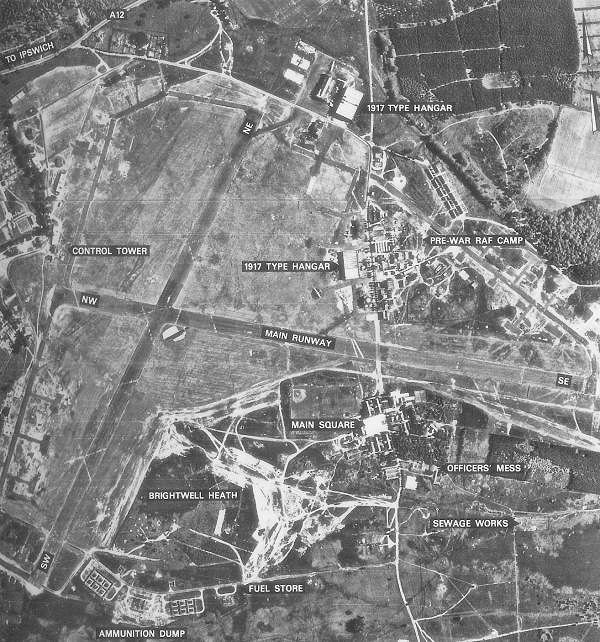Type Military airfield In use 1917-1963 Owner Air Ministry | Code MH Year built 1917 | |
 | ||
Battles/wars European Theatre of World War IIAir Offensive, Europe July 1942 - May 1945 Occupants Aeroplane and Armament Experimental Establishment, No. 11 Group RAF, 356th Fighter Group | ||
Raf martlesham heath one last take off
Royal Air Force Station Martlesham Heath or more simply RAF Martlesham Heath is a former Royal Air Force station located 1.5 miles (2.4 km) south west of Woodbridge, Suffolk, England. It was active between 1917 and 1963, and played an important role in the development of Airborne Interception radar.
Contents
- Raf martlesham heath one last take off
- Ex raf martlesham heath as it is in 2012
- RFCRAF prewar use
- RAF Fighter Command use
- USAAF use
- 356th Fighter Group
- Postwar RAF Fighter Command use
- Current use
- References
Ex raf martlesham heath as it is in 2012
RFC/RAF prewar use
Martlesham Heath was first used as a Royal Flying Corps airfield during World War I. In 1917 it became home to the Aeroplane Experimental Unit, RFC which moved from Upavon with the site named as the Aeroplane Experimental Station which became the Aeroplane and Armament Experimental Establishment (A&AEE) in 1924. The A&AEE carried the evaluation and testing of many of the aircraft types and much of the armament and other equipment that would later be used during World War II.
No. 22 Squadron RAF and No. 15 Squadron RAF were present during the 1920s. No. 64 arrived in the 1930s.
RAF Fighter Command use
The A&AEE moved to RAF Boscombe Down on 9 September 1939 at the outbreak of World War II and Martlesham then became the most northerly station of No. 11 Group RAF, Fighter Command. Squadrons of Bristol Blenheim bombers, Hawker Hurricanes, Supermarine Spitfires and Hawker Typhoons operated from this airfield, and among the many pilots based there were such famous men as Robert Stanford Tuck, and Squadron Leader Douglas Bader, there as Commanding Officer of 242 Squadron. Ian Smith, the post-war Rhodesian prime minister, was at Martlesham for a time.
No. 71 (Eagle) Squadron a squadron formed of American volunteers operated from the station in the middle and end of 1941.
USAAF use
In 1943, Martlesham Heath became one of a group of grass-surfaced airfields earmarked for use by fighters of the United States Army Air Forces (USAAF) Eighth Air Force. The airfield was assigned USAAF designation Station 369.
356th Fighter Group
The airfield was opened in May 1943 and was first used by the United States Army Air Forces Eighth Air Force 356th Fighter Group, arriving from RAF Goxhill on 5 October 1943. The group was under the command of the 67th Fighter Wing of the VIII Fighter Command. Aircraft of the 356th were identified by a magenta/blue diamond pattern around their cowling.
The group consisted of the following squadrons:
The 356th FG served in combat from October 1943, participating in operations that prepared for the invasion of the Continent, and supporting the landings in Normandy and the subsequent Allied drive across France and Germany.
The group flew Republic P-47 Thunderbolts until they were replaced by North American P-51 Mustangs in November 1944. From October 1943 until January 1944, they operated as escort for Boeing B-17 Flying Fortress/Consolidated B-24 Liberator bombers that attacked such objectives as industrial areas, missile sites, airfields, and communications.
Fighters from the 356th engaged primarily in bombing and strafing missions after 3 January 1944, with its targets including U-boat installations, barges, shipyards, aerodromes, hangars, marshalling yards, locomotives, trucks, oil facilities, flak towers, and radar stations. Bombed and strafed in the Arnhem area on 17, 18, and 23 September 1944 to neutralize enemy gun emplacements, and received a Distinguished Unit Citation for this contribution to the airborne attack on the Netherlands.
The group flew its last combat mission, escorting B-17's dropping propaganda leaflets, on 7 May 1945. It returned to Camp Kilmer New Jersey and was inactivated on 10 November 1945.
Postwar RAF Fighter Command use
With the departure of the USAAF, the airfield reverted to the RAF. In the immediate post-war years, Fighter Command squadrons were in residence at Martlesham but the proximity to Ipswich and the physical limitations on lengthening the runways restricted jet operation. In an effort to improve the station the main runway was extended in 1955.
Early in 1946, the Bomb Ballistics and Blind Landing Unit moved in which, in 1950, was rechristened the Armament and Instrument Experimental Unit (A&IEU) remaining at Martlesham until disbanding in 1957.
An RAF Police flight had also occupied the station from 1951–1953. The following year, the A&IEU was disbanded and the station was retained in reserve status during which time an Air Sea Rescue helicopter unit was in residence.
In 1958, another Reserve Flight arrived and a Station HQ formed; No. 11 Group Communications flight moved in to be followed by HO No. 11 Group. These units were deactivated by the end of 1960. The Battle of Britain Memorial Flight moved to the airfield in 1958 and left in 1961. After this the airfield reverted to care and maintenance status before the Air Ministry closed the facility on 25 April 1963.
Current use
With the end of military control, Martlesham Heath has now become an industrial and dormitory satellite of Ipswich and the four pre-war hangars and technical site buildings are now used for light industry and storage.
Nearby, on the old RAF parade ground, stands a memorial erected to the memory of those members of the 356th Fighter Group who lost their lives in World War II.
Part of the site of the airfield now contains the main headquarters building of the Suffolk Constabulary. The control tower from the airfield is maintained as a museum.
